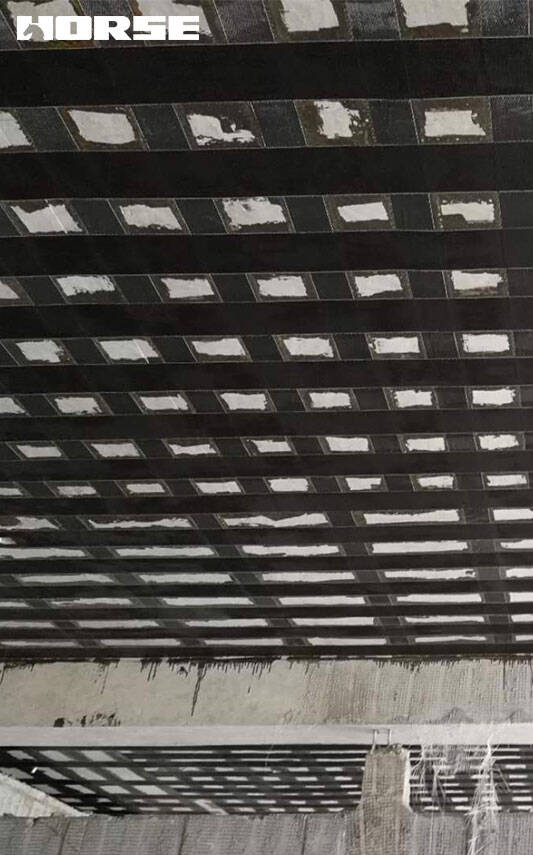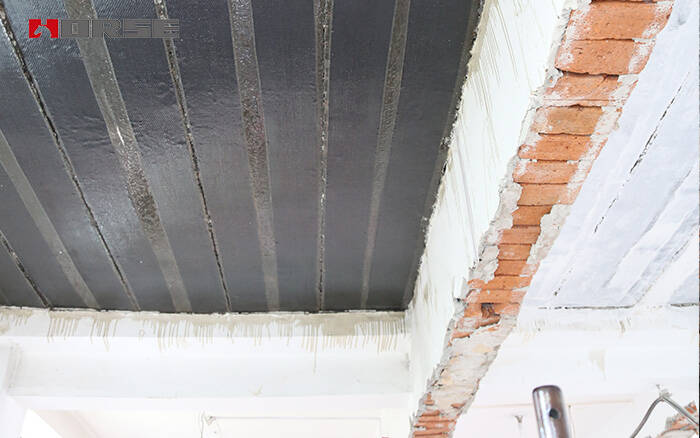Solutions
Horse Construction offers full range of structural strengthening materials with technical supports, documentation supports, products supports, project supports.
Carbon Fiber in Strengthening Corroded Reinforced Concrete Structure

Corroded reinforced concrete structures are divided into two situations, lightly corroded structures and heavily corroded structures. During structural reinforcement, different reinforcement methods are adopted for the two cases of corrosion damage. Slightly corroded structure refers to the corrosion of the steel bars inside the concrete structure, but the external concrete protective layer of the concrete component has not yet appeared along the reinforcement cracks, and the bearing capacity of the component has not been significantly reduced. Severely corroded structure means that the concrete structure has cracks along the tendons due to the expansion of steel bars, and some of the concrete has peeled off. The components cannot meet the basic requirements of the limit state of normal use and the limit state of bearing capacity specified in the code.
The corrosion reinforcement technology for heavily corroded reinforced concrete structures includes bonding steel reinforcement technology and fiber reinforced composite material (FRP) reinforcement technology. Fiber reinforced composite materials (abbreviated as FRP) mainly refer to carbon fiber (CFRP), square fiber (AFRP), and glass fiber (GFRP). The most popular research application in my country is carbon fiber (CFRP) reinforcement.
Damage type of concrete structure after reinforcement with carbon fiber
According to the literature, after the carbon fiber cloth is reinforced, the test found that its stress failure has the following characteristics.
When the CFRP reinforcement is too large. (For example, a beam with five layers of carbon fiber cloth) and reliable anchoring. It can cause super-reinforced damage, that is, before the tensile steel bar yields and the carbon fiber is broken. The concrete in the compression zone is crushed. With obvious brittle failure properties. When this kind of failure occurs, the stress of CFRP only reaches about 1/10 of its ultimate tensile strength, its strength is far from being fully utilized, and the brittleness at the time of failure is significant. Should be avoided. We can control by calculating the amount of carbon fiber cloth, that is, limiting the amount of CFRP reinforcement.
Another feature of brittle failure that should be avoided is that the protective layer concrete undergoes shear tensile peeling failure, which is the shear stress generated by the structural adhesive acting on the concrete surface. The combined action with normal stress causes horizontal cracks, which are generated and expanded with the horizontal cracks. Cause the concrete protective layer to be peeled off. Due to the bonding strength between the carbon fiber cloth and the structural adhesive, and between the structural adhesive and the concrete, the tensile strength of the concrete (or shallow concrete on the surface) is greater than that of the concrete (or the surface shallow concrete) under the condition of ensuring the quality of the paste. Therefore, most of the peeling failure occurs in the area of the component concrete protective layer. We can control this type of cracks through structural measures and the amount of carbon fiber cloth. For example, additional anchoring bead; increase the length of the anchor group; strictly control the construction quality; strictly carry out the surface treatment of the components. In addition, it is known from the literature that the low strength or insufficient anchorage length of the bonding material between the carbon fiber cloth (CFRP) and the concrete base layer can also cause the peeling failure between the cloth material and the concrete surface.
Both of the above two types of peeling failure have significant brittleness and should be avoided in application.
The design principle of carbon fiber cloth reinforcement for heavily corroded structures
The basic guiding ideas of carbon fiber cloth reinforcement design:
1) For the components with good appearance, less steel corrosion, and the concrete protective layer has not yet cracked, that is, the slightly corroded reinforced concrete structure. When calculating the bearing capacity, it can be considered that the strength of the steel bar and the concrete and the bond strength between them have not decreased. Therefore, for such components, if carbon fiber reinforcement is used, only preventive anti-corrosion reinforcement can be used to improve the corrosion resistance of the component in adverse environments. This type of reinforcement is structural reinforcement, and it is not necessary to calculate the required amount of carbon fiber cloth.
2) For severely corroded reinforced concrete structures where the concrete protective layer has been cracked, the corrosion of the steel bar will reduce the cross-sectional area of the steel bar and the strength of the steel bar will decrease, and the strength of the bond between the steel bar and the concrete will decrease. When carrying out carbon fiber reinforcement, the required number of longitudinal carbon fiber cloth should be calculated according to the different degree of structural corrosion to improve the bending resistance. Calculate the number of transverse carbon fiber cloth to improve the shear capacity. Here, it needs to be pointed out that structural reinforcement is to restore and improve the strength of the entire component, not to compensate for the loss of steel.

Reinforcement design for shear capacity of corroded components
Studies have proved that the mechanism of carbon fiber cloth in improving the shear capacity of beams is similar to that of stirrups. The improvement of the shear resistance of carbon fiber cloth is related to the following factors. The first category is the performance and original condition of the reinforced beam itself: including load condition, support condition, beam height-span ratio, shear-span ratio, concrete strength, reinforcement ratio, stirrup ratio, etc. The second category is the performance of reinforcement materials (including carbon fiber cloth and glue): including the thickness (number of layers) of CFRP, elastic modulus, anchoring length, ratio of shear span, elastic modulus of glue, shear strength, thickness, limit Elongation etc. Among the above influencing factors, the reinforcement ratio, the thickness (number of layers) of the CFRP, the shear span ratio, and the shear strength of the glue have a greater impact on the ultimate bearing capacity and failure characteristics.
Generally speaking, the more layers of carbon fiber cloth paste. The more the shear capacity of the reinforced beam is improved; with the same amount of carbon fiber, the reinforcement scheme with small strip spacing and fewer layers is better than the reinforcement scheme with large strip spacing and many layers.
There are two types of shear failure for the members reinforced with carbon fiber cloth. One is the tensile failure of the carbon fiber cloth pasted on the beam side; the other is the bond peeling failure between the carbon fiber cloth and the concrete on the beam side.
Carbon fiber cloth reinforcement features
Among the reinforcement technologies for corroded structural engineering, carbon fiber cloth reinforcement has the following characteristics compared with bonded steel reinforcement and electrochemical reinforcement:
1 Compared with electrochemical reinforcement technology, the advantages of carbon fiber cloth reinforcement
1) In the reinforcement of corroded structures, carbon fiber cloth can be laid and pasted on the required parts of the structure without changing the shape of the structure and without affecting the appearance of the structure. Especially for marine reinforced concrete structures, the bottom and sides of beams, slabs, ribs, and columns in the surge area. The cathodic protection system is difficult for the construction design of the bottom, side and special structure of the component. Sometimes it is difficult to achieve.
2) In the electrochemical reinforcement method, the cathodic protection system should increase the weight of the original structure. The carbon fiber cloth reinforcement basically does not increase the permanent load of the structure or increases very little. After the carbon fiber cloth is pasted, the weight per m is less than 1.0kg, and the thickness of the pasted layer is only 1mm. After the reinforcement and repair, the weight of the existing structure is basically not increased. And size.
3) The electrochemical reinforcement method cannot reliably evaluate the reinforcement effect; the carbon fiber cloth reinforcement can be calculated according to the calculation method of the concrete structure, so that the reinforcement effect can be guaranteed, and it is possible to calculate the service life and reliability of the structure after reinforcement.
Compared with bonded steel reinforcement technology, the advantages of carbon fiber cloth reinforcement
1) The operation of bonding steel reinforcement technology is complicated. Carbon fiber cloth reinforcement construction is convenient, efficient, and has good operability. There is no need for bolts or rivets during reinforcement construction, which has little disturbance to the existing structure, will not affect the integrity of the existing structure, and the construction quality is easy to guarantee.
2) Bonded steel reinforcement technology cannot be used in salty soil environment, marine environment, and chemical erosion environment. Therefore, it is restricted in the reinforcement of corrosion projects in underground structures, water supply and drainage structures, hydraulic structures, port structures, chemical workshops, etc. The investigation shows that these types of structures are the most severely damaged structures due to rust expansion.
You can find anything here you are in need of, have a trust trying on these products, you will find the big difference after that.

High strength, unidirectional carbon fiber wrap pre-saturated to form a carbon fiber reinforced polymer (CFRP) wrap used to strengthen structural concrete elements.

High strength, unidirectional carbon fiber fabric pre-saturated to form a carbon fiber reinforced polymer (CFRP) fabric used to strengthen structural concrete elements.

High strength, unidirectional carbon fiber sheet pre-saturated to form a carbon fiber reinforced polymer (CFRP) sheet used to strengthen structural concrete elements.